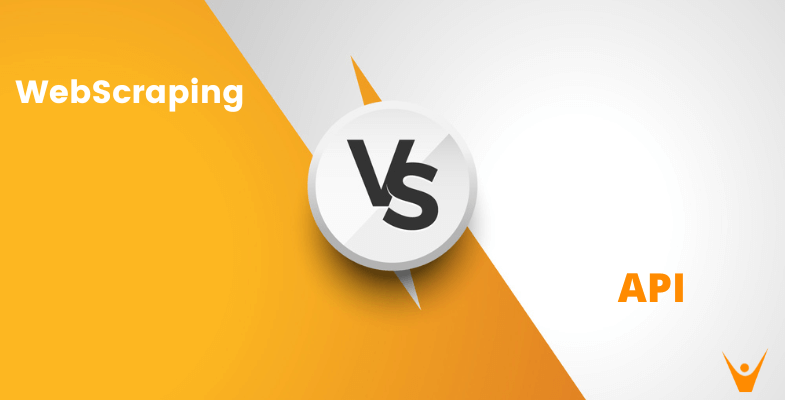Introduction to Web Scraping
Web scraping is the process of extracting data from websites or specific web pages. It involves retrieving information, such as text, images, or videos, from publicly available web pages and storing it in a structured format for further analysis. Web scraping can be done manually, but it is more commonly performed using software tools called web scrapers.
Web scrapers are designed to automate the data extraction process, making it faster, more efficient, and less error-prone compared to manual scraping. These tools can navigate through websites, locate desired data elements, and extract them in a structured format, such as CSV or JSON. With web scraping, users have the flexibility to select any website and extract the data they need.
Understanding APIs
API stands for Application Programming Interface. It is a set of procedures and protocols that allows different software applications to communicate and exchange data with each other. APIs serve as intermediaries, enabling developers to access specific data or functionality from an application or service.
APIs are commonly used to access data from various sources, such as social media platforms, weather services, financial databases, and more. By providing a standardized interface, APIs simplify data integration and enable developers to build applications that utilize the data and services offered by different platforms. APIs can be accessed through API calls, where developers send requests to the API endpoint and receive responses containing the requested data.
Web Scraping vs API: Fundamental Differences
While web scraping and APIs both serve the purpose of accessing web data, they differ in several fundamental aspects. Let's explore the key differences between web scraping and APIs in terms of accessing data, technical implementation, and data customization.
Accessing Data
Web scraping allows users to extract data from any website or web page. As long as the data is publicly available on a website, it can be scraped using web scraping tools. Users have the freedom to choose the websites they want to scrape and define the specific data elements they need.
On the other hand, APIs provide direct access to data from specific applications, operating systems, or services. APIs rely on the owners of the data, who define the terms of access, such as whether the API is available for free or requires a subscription. APIs often have limitations, such as the number of requests allowed per user or the level of detail in the data provided. Users can only access the data that is made available through the API.
Technical Implementation
Web scraping can be implemented using various tools and programming languages. There are web scraping software tools available that simplify the process and allow users to create scraping projects without extensive programming knowledge. These tools provide intuitive interfaces for defining scraping rules, navigating websites, and extracting data.
APIs, on the other hand, require developers to interact with the API endpoints using programming languages and tools. Developers need to understand the API documentation, make API calls with the appropriate parameters, and handle the responses to retrieve the desired data. While APIs offer more control and flexibility in terms of data retrieval, they require a higher level of technical expertise compared to web scraping.
Data Customization and Limitations
Web scraping provides more flexibility and customization options compared to APIs. With web scraping, users can extract specific data elements from multiple websites and organize them in a structured format of their choice. They have control over the scraping process, including the selection of websites, data extraction rules, and data formatting.
APIs, on the other hand, have predefined data structures and limitations set by the data owners. Users can only access the data that is made available through the API, and they may have limited control over the format or structure of the data. APIs are designed to provide specific sets of data, and customization options may be limited or non-existent.
Web Scraping and APIs in Practice
Both web scraping and APIs have practical applications in various industries and use cases. Let's explore some common scenarios where web scraping and APIs are utilized.
Use Cases for Web Scraping
Web scraping is widely used for market research, competitor analysis, content aggregation, lead generation, and more. Here are some examples of how web scraping is applied in real-world scenarios:
- E-commerce Price Monitoring: Businesses can scrape e-commerce websites to gather pricing data for competitor analysis and dynamic pricing strategies.
- News Aggregation: News organizations and content aggregators use web scraping to collect news articles from different sources and create comprehensive news feeds.
- Job Listings: Job portals scrape company websites and job boards to gather job listings for their platforms, providing users with up-to-date job opportunities.
- Real Estate Data: Real estate companies scrape property listings from various websites to analyze market trends, monitor prices, and identify investment opportunities.
For a detailed guide on how to web scrape using PHP, you can check out this resource that provides valuable insights into PHP-based web scraping.
Use Cases for APIs
APIs are utilized in a wide range of applications, including social media integration, weather forecasts, financial data analysis, and more. Here are some examples of how APIs are used in practical scenarios:
- Social Media Integration: Applications and websites integrate social media APIs to allow users to sign in using their social media accounts and share content seamlessly.
- Weather Forecasts: Weather apps and websites rely on weather APIs to fetch real-time weather data, including temperature, humidity, and precipitation forecasts.
- Financial Data Analysis: Financial institutions and investment firms use financial APIs to access stock market data, exchange rates, and economic indicators for investment analysis and decision-making.
- Geolocation Services: Mapping and navigation applications leverage geolocation APIs to provide users with accurate location-based services, such as finding nearby restaurants or tracking delivery orders.
Choosing Between Web Scraping and APIs
Choosing the appropriate method, whether web scraping or APIs, depends on various factors, including data availability, technical requirements, and customization needs. Let's explore the key considerations when deciding between web scraping and APIs.
Factors to Consider
When deciding between web scraping and APIs, consider the following factors:
- Data Availability: Check if the data you need is available through an API. If an API is not available or does not provide the desired data, web scraping may be the only option.
- Technical Expertise: Assess your technical capabilities and resources. Web scraping may be more accessible to users without extensive programming knowledge, while APIs require development skills.
- Data Customization: Determine if you require customized data extraction and formatting. Web scraping offers more flexibility in defining scraping rules and data organization.
- Data Volume and Frequency: Consider the volume of data you need to extract and the frequency of updates. APIs may have limitations on the number of requests or real-time data availability.
- Legal and Ethical Considerations: Ensure that your data extraction method complies with the website's terms of service and legal requirements. Respect website policies and avoid excessive requests that may overload servers.
When to Use Web Scraping
Web scraping is an ideal choice in the following scenarios:
- The desired data is not available through an API.
- Customized data extraction and formatting are required.
- Access to a large volume of data from multiple websites is needed.
- Real-time data updates are necessary.
- Limited technical expertise or programming knowledge is available.
When to Use APIs
Consider using APIs in the following situations:
- The desired data is available through an API.
- Real-time data updates are not required.
- Specific data sets or functionality are needed from an application or service.
- Advanced customization options are not necessary.
- Adequate technical expertise or development resources are available.
Best Practices for Web Scraping
Web scraping, while a powerful tool for data extraction, should be performed responsibly and ethically. Here are some best practices to follow when engaging in web scraping:
Respecting Website Policies
- Review the website's terms of service and respect their policies regarding data scraping.
- Check for a website's robots.txt file, which outlines which parts of the website can be scraped and any specific restrictions.
- Avoid scraping sensitive or private data, such as personal information or copyrighted content.
Using Proxy Servers
- Utilize proxy servers to avoid overwhelming websites with excessive requests and to maintain anonymity.
- Rotate IP addresses to prevent being blocked by websites that impose restrictions on scraping activities.
- Ensure that your scraping activities do not disrupt or impact the performance of the website or its users.
Avoiding Overwhelming Servers
- Implement rate limiting and throttling mechanisms to control the frequency and volume of requests sent to a website.
- Respect any rate limits imposed by the website or API to avoid overloading the server and potentially being blocked.
- Optimize your scraping code to minimize unnecessary requests and reduce the strain on the website's servers.
Conclusion
In conclusion, web scraping and APIs are valuable tools for accessing and retrieving data from websites. While web scraping offers more flexibility and customization options, APIs provide direct access to specific data sets with predefined structures. Understanding the differences between web scraping and APIs is crucial for businesses, developers, and data enthusiasts to make informed decisions about the most suitable method for their data extraction needs. By following best practices and considering key factors, you can leverage the power of web scraping and APIs to unlock valuable insights and drive innovation in your industry.








